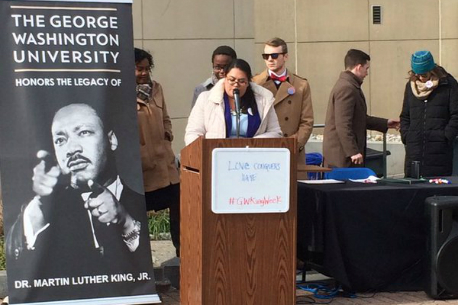First-year PAF Zinhle Essamuah delivered a two part presentation series on one of our PAF professional development competencies – motivating others. She provided not only a theoretical understanding grounded by in-group experience, but also a chance to practice the skill with fun activities. During Spring Training, fellows had the opportunity to participate in GW’s King Week by reciting excerpts of Dr. King’s speeches in Kogan Plaza. Reflecting on the activity, we concluded that reading Dr. King’s words to a crowd was a moving experience that left us inspired by Dr. King’s words. At our February 2nd weekly meeting, we also did a True Colors activity related to motivating different colors.
According to Psychology Today, “motivation” is literally the desire to do things; and it can be intrinsic or extrinsic. Intrinsic motivation occurs when someone is motivated to do something for its own sake and without external reward. Extrinsic motivation is when someone is motivated to perform an activity to either avoid punishment or earn a reward. Armed with a basic understanding of what motivation is and what it can look like, our attention turned to how we can motivate others. Using the launching pad of our King Week experience, Zinhle led the discussion from a civil rights perspective. There are three important reasons to motivate others: to mobilize, promote understanding, and create solidarity.
As lawmakers and stakeholders pursue immigration reform, one important method of mobilizing others is equipping them with information. This can take the form of advocacy packets or website content. To promote understanding, it’s important to clarify your goals. A key example is the #BlackLivesMatter movement and its distinction from the idea that all lives matter. Lastly, in order to build solidarity it’s important to help your audience find their connection to the issue. A prime example is the movement for marriage equality. As people used the rainbow filter and #LoveIsLove hashtag on social media, it allowed others to see how this issue affected their own social network.
The second part of Zinhle’s presentation concluded with an activity that incorporated our True Color personality types. The True Color test helps people identify their strengths and challenges. Grouped by color, fellows and members of the advising team were tasked with writing and delivering a speech geared towards a specific color group. Causes included gun control, immigration reform, #BlackLivesMatter, and environmental issues. The “oranges,” represented by second-year PAF Ashlynn Profit and PAF Program Director Robert Snyder, delivered a lively speech tailored toward the gold group. Their speech appealed to gold personalities by including specific steps they could take, discussing long and short-term goals, and opening the floor for constructive feedback and ideas.
Check out these strategies to appeal to certain personality types.
How to Motivate Golds
- Provide specific, detailed instructions
- Discuss short and long-term goals
- Trust and respect them
- Provide and request constructive feedback
How to Motivate Greens
- Provide deadlines
- Give them space to think creatively
- Focus on how they can improve something
- Contextualize using the bigger picture
How to Motivate Blues
- Use a positive, team-oriented attitude
- Make them understand their stake in the issue
- Focus on constant communication
How to Motivate Oranges
- Recognize their achievement
- Appeal to their desire to solve problems
- Make your ask fun and stimulating



